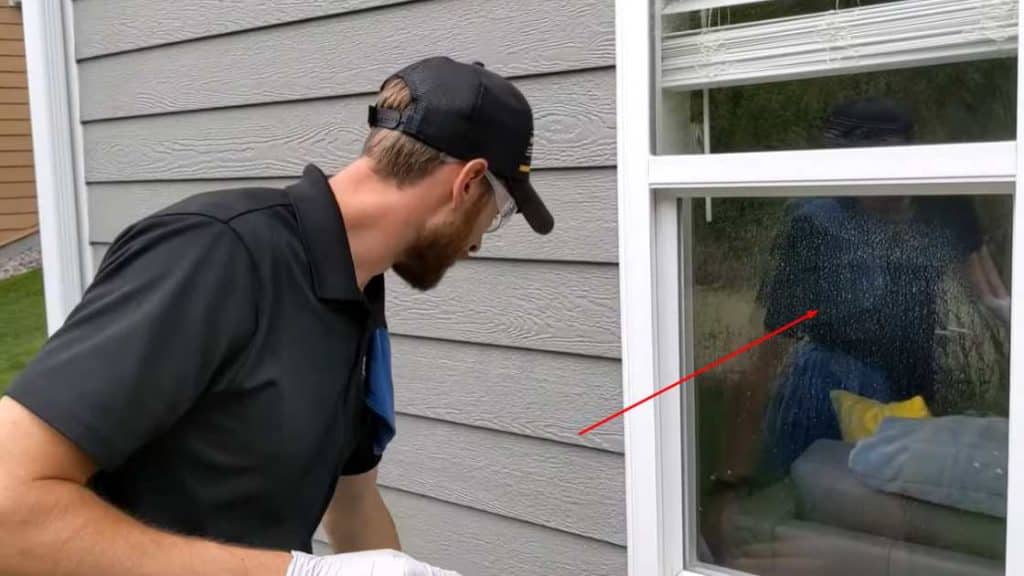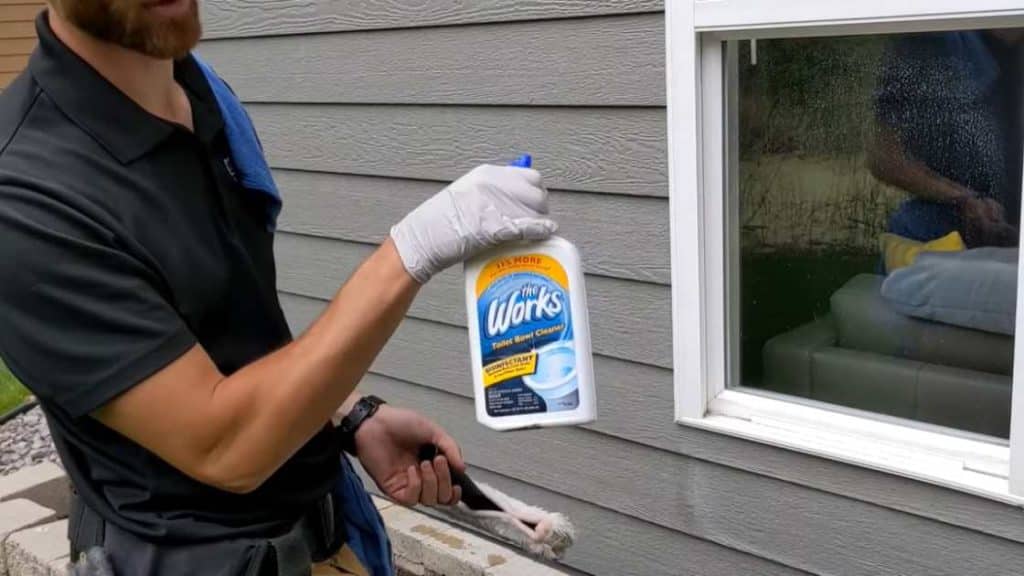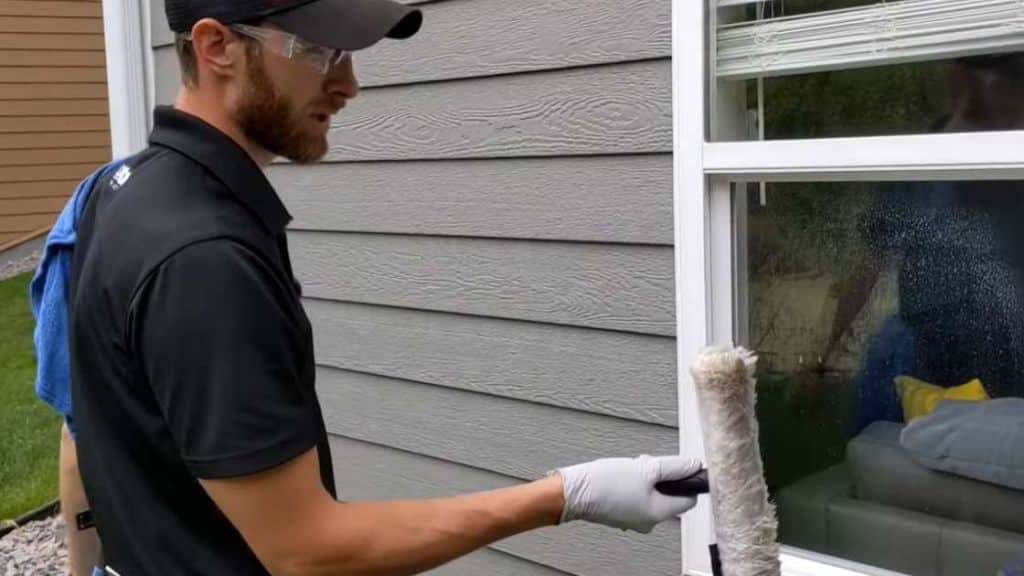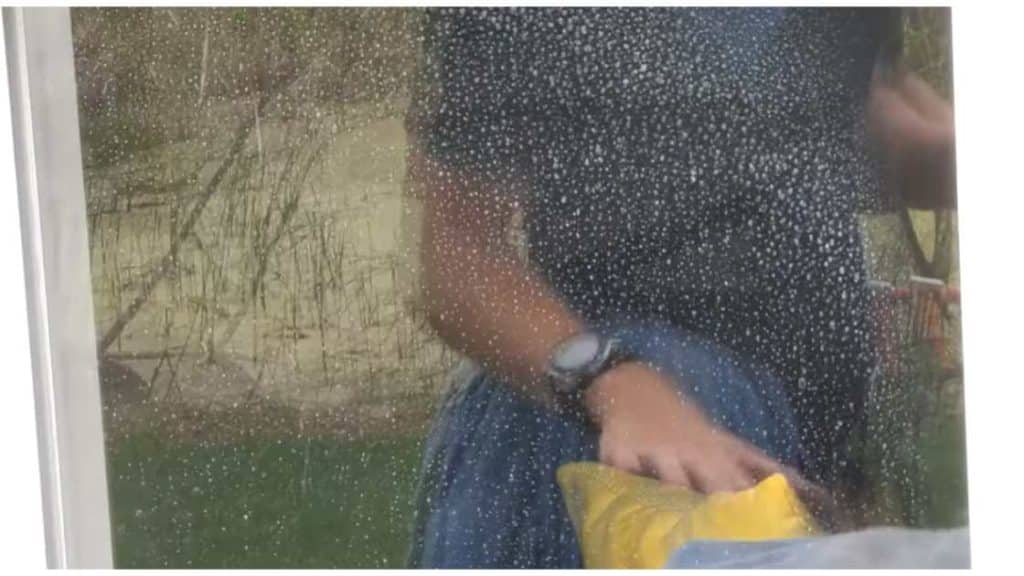If you are worried about water stained windows. Then don’t worry about it anymore. today’s blog I am going to show you how to clean water stained windows easiest way possible.
To clean water-stained windows, create a mixture of vinegar and water, then spray and wipe down the glass. Use a soft microfiber cloth to avoid scratches.
Dealing with water stains on windows can be frustrating, but it’s a common household issue that has a straightforward solution.
Crystal clear windows enhance the aesthetic appeal of your home and let more natural light in, making your living spaces brighter and seemingly more spacious.
Regular maintenance not only keeps your windows sparkling but can also extend the life of the glass by preventing long-term damage from mineral deposits and water spots.

This guide will provide you with simple, effective methods to tackle those stubborn stains and maintain the clarity of your windows without the need for harsh chemicals or expensive cleaning services.
The right approach can not only save time but also leave your windows looking as good as new with minimal effort.
Introduction To Water Stains On Windows
Sparkling windows brighten up your home. But what about those pesky water stains? They leave your windows looking dull.
This happens after rain, sprinkler sprays, or incorrect cleaning. Don’t worry; this guide dives into getting rid of water stains and maintaining clear windows.
Understanding Water Stains
Water stains on windows can be a nuisance. They occur due to minerals in water, such as calcium and magnesium.
When water evaporates, these minerals stay behind, leaving a visible trace. This is often seen after rain or using hard water to clean windows.
Knowing what causes water stains is key. It helps you choose the right cleaning method.
The Importance Of Clean Windows
Clean windows are not just about looks. They let in more light and improve your view. Dirty windows can block sunlight and make your space feel gloomy.
Furthermore, regular cleaning protects your windows from permanent damage caused by accumulated minerals.
Common Causes Of Water Stains On Windows
Spotted windows can detract from the beauty of your home. Understanding the culprits behind these persistent stains is the first step towards achieving a sparkling finish.
Several factors lead to the unsightly appearance of water stains on your windows. Let’s delve into the most common causes:
Hard Water Deposits
Regions with hard water have high levels of minerals. When water evaporates from your windows, minerals like calcium and magnesium remain, forming a crusty haze.
- Water from sprinklers often contains these minerals.
- Hard water can be problematic when cleaning without the proper tools.
Environmental Pollutants And Debris
Your windows face environmental pollutants daily. Pollen, dust, and industrial pollutants can all mix with water to create a stubborn film.
| Environmental Factors | Impact on Windows |
|---|---|
| Airborne Pollutants | Stick to wet surfaces, causing stains |
| Pollen and Organic Matter | Create streaks when mixed with rain |
Improper Window Cleaning Techniques
The way you clean can leave behind more than you might expect.
Improper techniques push the dirt around, leaving streaks.
- Using unclean tools leads to dirty water marks.
- Wiping windows with already contaminated clothes spreads grime.
- Not drying windows adequately results in mineral deposits.
Tools And Materials Needed For Removing Water Stains
If sparkling, clear windows sound like a dream, we’re here to make it a reality. Water stains can cloud your view, but fear not. Gather a few common tools and materials to renew your windows. Let’s gear up to tackle those pesky water stains.
Essential Cleaning Supplies
Start by rounding up these supplies:
| Cleaning Agents | Tools |
|---|---|
| Vinegar or lemon juice | Bucket |
| Baking soda | Soft-bristle brush |
| Distilled water | Sponge or microfiber cloth |
| Rubbing alcohol (optional) | Squeegee |
- Vinegar cuts through mineral deposits.
- Baking soda acts as a mild abrasive.
- Use distilled water for a streak-free rinse.
- A brush and sponge help scrub away stains.
- A squeegee provides a clean, clear finish.
Protective Equipment
Safety always comes first. Make sure to wear:
- Gloves to protect your hands.
- Goggles to shield your eyes.
Wearing gloves keeps harsh substances away from your skin. Goggles prevent splashes from reaching your eyes.
With these tools and safety gear, removing water stains is now simple and safe.
Diy Solutions For Cleaning Water Stained Windows

Water stains on windows can be an unsightly challenge. Whether it’s from rain, sprinklers, or a messy storm, those mineral deposits can obscure your view.
Fortunately, a mix of everyday household items and elbow grease can restore your windows to their sparkling glory. Try these simple DIY methods to tackle those stubborn water stains.
Vinegar And Water Solution
Vinegar is a versatile cleaner, perfect for removing hard water stains. Its acidity cuts through the deposits, leaving your windows clear.
- Combine equal parts of white vinegar and water.
- Pour into a spray bottle.
- Spray the solution onto the stains.
- Let sit for a minute, then scrub with a soft brush or cloth.
- Rinse with clean water and dry with a squeegee or lint-free towel.
Lemon Juice And Salt Mixture
Lemon’s natural acidity and salt’s abrasive texture make a powerful cleaning duo. They work together to break down and lift off water stains.
- Squeeze fresh lemon juice onto the stained area.
- Spread a thin layer of salt over the juice.
- Allow the mixture to work its magic for five minutes.
- Gently scrub the stain with a cloth or sponge.
- Wash the window with water and dry.
Commercial Window Cleaners
For those tough, persistent stains, a commercial window cleaner might be the solution. They’re formulated to tackle hard water marks and give a streak-free finish.
| Product | Application | Instructions |
|---|---|---|
| Commercial Cleaner A | Spray | Apply, leave for two minutes, scrub, and rinse. |
| Commercial Cleaner B | Wipe | Apply with a cloth, and wipe in circular motions, no rinse is needed. |
Select a cleaner designed for mineral deposits. Follow the instructions carefully for the best results.
Remember: Always test these solutions on a small window area first. This ensures they won’t damage the glass.
Step-by-step Guide To Cleaning Water Stains
Sparkling windows can transform your space, but water stains often spoil the view. These pesky marks are caused by minerals in the water.
Over time, they can become quite stubborn. But don’t worry, our step-by-step guide will show you how to tackle them effectively.
We’ll start with some initial cleaning, move on to a powerful cleaning solution, and finish with proper rinsing and drying techniques. Let’s make those windows shine!
Initial Cleaning Procedures
Before you apply any special cleaning solutions, it’s important to give your windows a basic clean.
- Remove loose dirt: Use a soft brush to whisk away dust and dirt.
- Wash with water: Splash the window with plain water to wet the surface.
- Wipe with a sponge: Gently scrub the window with a soft sponge.
- Use soapy water: If needed, a mild detergent can help remove initial grime.
Applying The Cleaning Solution
For tough water stains, a stronger solution comes in handy.
- Mix your solution: Combine vinegar and water in equal parts.
- Apply to stains: Soak a cloth in the solution and place it on the stains.
- Let it sit: Allow it to work for 15 minutes to loosen mineral deposits.
- Scrub: Use a non-abrasive sponge or cloth to scrub gently.
Rinsing And Drying Techniques
Proper rinsing and drying are the final steps to a streak-free finish.
- Rinse thoroughly: Remove all traces of the cleaning solution with clean water.
- Dry properly: Use a squeegee or a lint-free towel to dry the window.
- Buff the window: A dry microfiber cloth can add a sparkling touch.
Tip: Tackle water stains on a cloudy day. Direct sunlight can cause the cleaning solution to dry too quickly, leaving new streaks on the glass.
Preventing Future Water Stains On Windows
Preventing Future Water Stains on Windows ensures your windows stay crystal clear. Learn how to safeguard them and reduce your cleaning efforts.
Practicing proper maintenance and using water repellent can keep those pesky water stains at bay.
Regular Maintenance Tips
- Clean windows monthly to avoid hard water build-up.
- Use a soft squeegee to wipe away water quickly.
- Microfiber towels come in handy for drying edges.
- Inspect seals regularly for leaks that cause moisture.
- Prune nearby plants and trees to limit water splash.
Water Repellent Treatments
Applying a water repellent is like a shield for your windows. It can significantly reduce water stain formation. Here’s how to apply:
- Clean the window thoroughly before treatment.
- Apply the water repellent evenly across the surface.
- Use a clean cloth to buff the window until it’s streak-free.
Products for water repellency come in various forms:
| Product Type | Frequency of Application |
|---|---|
| Liquid Repellent | Every 3-6 months |
| Spray Repellent | Every 1-2 months |
| Nano-based Coatings | Once a year |
Professional Cleaning Vs. Diy For Water Stains

The dilemma of tackling water stains on windows often leads to a crossroads: professional cleaning services or a DIY approach.
Both methods boast their merits, but understanding the nuances of each can save time and money while ensuring sparkling results.
This discussion will illuminate the difference between professional cleaning and DIY methods for stubborn water stains.
When To Call The Professionals
Some situations demand expert intervention. Water stains can sometimes be a symptom of deeper issues, such as hard water mineral deposits or etched glass that DIY methods cannot address.
Excessively stained windows or those in hard-to-reach places also warrant professional expertise.
- Hard-to-remove stains: Professional tools and solutions may be necessary.
- High or large windows: Professionals can safely clean these.
- Risk of damage: To avoid scratching or further damage, experts should handle it.
Cost-benefit Analysis Of Diy Vs. Professional Cleaning
| Aspect | DIY | Professional |
|---|---|---|
| Cost | Lower upfront, costs in supplies. | Higher upfront, no additional expenses. |
| Time | Varies by effort and skill. | Minimal, professionals work quickly. |
| Results | Dependent on technique. | Consistently high-quality. |
| Safety | Potential risk if not properly equipped. | Handled by experienced technicians. |
Deciding between DIY and professional window cleaning doesn’t only hinge on cost. Evaluate personal safety, time investment, and the potential for impeccable results.
For straightforward, minor blemishes, a DIY approach with common household items like vinegar can be effective.
Otherwise, the convenience and assured effectiveness of professional services might justify the expense.
Remember, clear windows don’t just offer a better view. They also enhance the overall appeal and value of a property. Choose the right method to bring back their shine and ensure their longevity.
Frequently Asked Questions For How To Clean Water Stained Windows
How Do You Get Old Water Stains Off Glass Windows?
To remove old water stains from glass windows, mix equal parts white vinegar and water in a spray bottle. Apply the solution to the stains, let it sit for a minute, then wipe off with a clean, lint-free cloth. Repeat if necessary for stubborn stains.
What Is The Best Cleaner For Water Stained Glass?
The best cleaner for water-stained glass is a mixture of white vinegar and water. Apply with a soft cloth, rinse thoroughly, and dry for clear results.
Can Hard Water Stains Be Removed From Glass?
Yes, hard water stains can be removed from glass. Use a mixture of vinegar and water, or a specialized glass cleaner and a soft cloth for effective cleaning.
Will Magic Eraser Remove Hard Water Stains From Windows?
Yes, a Magic Eraser can effectively remove hard water stains from windows. Use it gently to avoid scratches.
Conclusion
Restoring the sparkle to your windows doesn’t have to be an uphill battle. With the right technique and a bit of elbow grease, those pesky water stains will be a thing of the past. Embrace the clarity of streak-free glass and enjoy the unobstructed views of your surroundings.
Remember, regular maintenance is key to keeping windows crystal clear. Happy cleaning!

